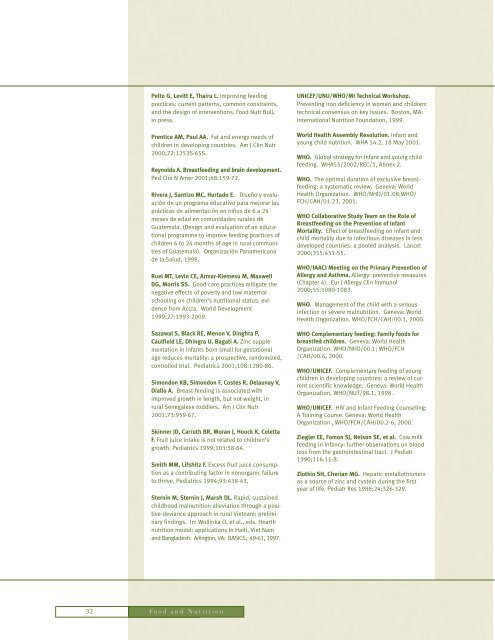Guiding Principles for Complementary Feeding of the Breastfed
Guiding Principles for Complementary Feeding of the Breastfed
Guiding Principles for Complementary Feeding of the Breastfed
You also want an ePaper? Increase the reach of your titles
YUMPU automatically turns print PDFs into web optimized ePapers that Google loves.
Pelto G, Levitt E, Thairu L. Improving feeding<br />
practices: current patterns, common constraints,<br />
and <strong>the</strong> design <strong>of</strong> interventions. Food Nutr Bull,<br />
in press.<br />
Prentice AM, Paul AA. Fat and energy needs <strong>of</strong><br />
children in developing countries. Am J Clin Nutr<br />
2000;72:1253S-65S.<br />
Reynolds A. Breastfeeding and brain development.<br />
Ped Clin N Amer 2001;48:159-72.<br />
Rivera J, Santizo MC, Hurtado E. Diseño y evaluación<br />
de un programa educativo para mejorar las<br />
prácticas de alimentación en niños de 6 a 24<br />
meses de edad en comunidades rurales de<br />
Guatemala. (Design and evaluation <strong>of</strong> an educational<br />
programme to improve feeding practices <strong>of</strong><br />
children 6 to 24 months <strong>of</strong> age in rural communities<br />
<strong>of</strong> Guatemala). Organización Panamericana<br />
de la Salud, 1998.<br />
Ruel MT, Levin CE, Armar-Klemesu M, Maxwell<br />
DG, Morris SS. Good care practices mitigate <strong>the</strong><br />
negative effects <strong>of</strong> poverty and low maternal<br />
schooling on children’s nutritional status: evidence<br />
from Accra. World Development<br />
1999;27:1993-2009.<br />
Sazawal S, Black RE, Menon V, Dinghra P,<br />
Caulfield LE, Dhingra U, Bagati A. Zinc supplementation<br />
in infants born small <strong>for</strong> gestational<br />
age reduces mortality: a prospective, randomized,<br />
controlled trial. Pediatrics 2001;108:1280-86.<br />
Simondon KB, Simondon F, Costes R, Delaunay V,<br />
Diallo A. Breast-feeding is associated with<br />
improved growth in length, but not weight, in<br />
rural Senegalese toddlers. Am J Clin Nutr<br />
2001;73:959-67.<br />
Skinner JD, Carruth BR, Moran J, Houck K, Coletta<br />
F. Fruit juice intake is not related to children’s<br />
growth. Pediatrics 1999;103:58-64.<br />
Smith MM, Lifshitz F. Excess fruit juice consumption<br />
as a contributing factor in nonorganic failure<br />
to thrive. Pediatrics 1994;93:438-43.<br />
Sternin M, Sternin J, Marsh DL. Rapid, sustained<br />
childhood malnutrition alleviation through a positive-deviance<br />
approach in rural Vietnam: preliminary<br />
findings. In: Wollinka O, et al., eds. Hearth<br />
nutrition model: applications in Haiti, Viet Nam<br />
and Bangladesh. Arlington, VA: BASICS, 49-61, 1997.<br />
32 Food and Nutrition<br />
UNICEF/UNU/WHO/MI Technical Workshop.<br />
Preventing iron deficiency in women and children:<br />
technical consensus on key issues. Boston, MA:<br />
International Nutrition Foundation, 1999.<br />
World Health Assembly Resolution. Infant and<br />
young child nutrition. WHA 54.2, 18 May 2001.<br />
WHO. Global strategy <strong>for</strong> infant and young child<br />
feeding. WHA55/2002/REC/1, Annex 2.<br />
WHO. The optimal duration <strong>of</strong> exclusive breastfeeding:<br />
a systematic review. Geneva: World<br />
Health Organization. WHO/NHD/01.08;WHO/<br />
FCH/CAH/01.23, 2001.<br />
WHO Collaborative Study Team on <strong>the</strong> Role <strong>of</strong><br />
Breastfeeding on <strong>the</strong> Prevention <strong>of</strong> Infant<br />
Mortality. Effect <strong>of</strong> breastfeeding on infant and<br />
child mortality due to infectious diseases in less<br />
developed countries: a pooled analysis. Lancet<br />
2000;355:451-55.<br />
WHO/IAACI Meeting on <strong>the</strong> Primary Prevention <strong>of</strong><br />
Allergy and Asthma. Allergy: preventive measures<br />
(Chapter 4). Eur J Allergy Clin Immunol<br />
2000;55:1080-1083.<br />
WHO. Management <strong>of</strong> <strong>the</strong> child with a serious<br />
infection or severe malnutrition. Geneva: World<br />
Health Organization. WHO/FCH/CAH/00.1, 2000.<br />
WHO <strong>Complementary</strong> feeding: Family foods <strong>for</strong><br />
breastfed children. Geneva: World Health<br />
Organization. WHO/NHD/00.1; WHO/FCH<br />
/CAH/00.6, 2000.<br />
WHO/UNICEF. <strong>Complementary</strong> feeding <strong>of</strong> young<br />
children in developing countries: a review <strong>of</strong> current<br />
scientific knowledge. Geneva: World Health<br />
Organization, WHO/NUT/98.1, 1998.<br />
WHO/UNICEF. HIV and Infant <strong>Feeding</strong> Counseling:<br />
A Training Course. Geneva: World Health<br />
Organization , WHO/FCH/CAH/00.2-6, 2000.<br />
Ziegler EE, Fomon SJ, Nelson SE, et al. Cow milk<br />
feeding in infancy: fur<strong>the</strong>r observations on blood<br />
loss from <strong>the</strong> gastrointestinal tract. J Pediatr<br />
1990;116:11-8.<br />
Zlotkin SH, Cherian MG. Hepatic metallothionein<br />
as a source <strong>of</strong> zinc and cystein during <strong>the</strong> first<br />
year <strong>of</strong> life. Pediatr Res 1988;24:326-329.

















